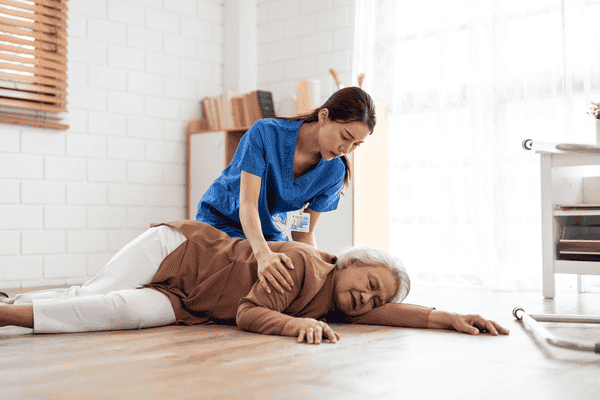When Sarah noticed her 78-year-old father struggling to rise from his favorite armchair—something he’d done effortlessly for decades—she initially attributed it to a “bad day.” But when the same difficulty persisted week after week, accompanied by slower walks to the mailbox and complaints of feeling “weaker than usual,” she realized something more significant was happening. What Sarah was witnessing were the early warning signs of sarcopenia, a condition that affects millions of older adults but often goes unrecognized until its impact becomes undeniable.
Sarcopenia represents far more than the natural aging process we might expect. This age-related loss of muscle mass and strength affects between 5-13% of people aged 60-70 and a staggering 11-50% of those over 80. The condition doesn’t merely make daily tasks more challenging—it fundamentally alters an older adult’s independence, mobility, and quality of life. Yet here’s the encouraging truth that many families don’t realize: with the right knowledge and consistent action, sarcopenia’s progression can be significantly slowed or even prevented.
Family members and caregivers occupy a unique and powerful position in this fight against muscle loss. Unlike healthcare providers who see patients periodically, you observe daily changes, notice subtle shifts in energy or capability, and possess the influence to encourage positive lifestyle modifications. Your role extends beyond simple observation—you become the catalyst for preventive action that can preserve your loved one’s strength, independence, and vitality for years to come.
Understanding Why Prevention Matters More Than Treatment
The consequences of untreated sarcopenia extend far beyond muscle weakness, creating a cascade of health challenges that dramatically impact every aspect of an older adult’s life. When muscle strength diminishes, the risk of falls increases exponentially, often leading to fractures that can fundamentally alter mobility and independence. But the effects don’t stop there—sarcopenia weakens the immune system, making recovery from illness more difficult and prolonged.
Consider how muscle loss affects seemingly simple daily activities. Rising from bed becomes a struggle. Climbing stairs transforms from routine movement to exhausting effort. Even basic tasks like opening jars or carrying groceries become sources of frustration and dependency. These challenges often lead to a vicious cycle where reduced activity accelerates further muscle loss, creating an increasingly difficult situation to reverse.
The medical complications associated with sarcopenia paint an even more concerning picture. Weakened muscles can affect swallowing, increasing the risk of choking or aspiration pneumonia. Wound healing slows significantly when the body lacks adequate muscle mass to support recovery processes. The psychological impact cannot be overlooked either—losing physical capability often leads to depression, social isolation, and a diminished sense of self-worth.
However, prevention offers hope and tangible benefits that extend well beyond maintaining muscle mass. When families actively support sarcopenia prevention, they’re investing in their loved one’s continued independence, reduced healthcare costs, and enhanced quality of life. The beauty of prevention lies in its accessibility—simple, consistent lifestyle changes can yield remarkable results without requiring expensive interventions or complex medical treatments.
Creating a Foundation Through Nutrition
Building Strength Through Protein
The cornerstone of sarcopenia prevention rests on adequate protein intake, yet many older adults consume far less than their bodies require for maintaining muscle mass. Research consistently shows that adults over 65 need approximately 1.0-1.5 grams of protein per kilogram of body weight daily. For practical understanding, a 70-kilogram person requires between 70-105 grams of protein each day—significantly more than many seniors typically consume.
The challenge lies not just in quantity but in distribution throughout the day. Rather than consuming most protein at dinner, spreading intake across meals maximizes muscle protein synthesis. Consider transforming breakfast from toast and coffee to scrambled eggs with spinach and cheese. This simple change can provide 20-25 grams of high-quality protein to start the day. Lunch might feature grilled chicken with vegetables, adding another 25-30 grams, while an afternoon snack of Greek yogurt with nuts contributes an additional 15-20 grams.
For families concerned about meal planning, focus on incorporating protein-rich foods that align with your loved one’s preferences and abilities. Soft proteins like eggs, fish, and dairy products work well for those with chewing difficulties. Plant-based options such as beans, lentils, and tofu provide alternatives for different dietary preferences. When appetite becomes an issue, protein powders mixed into smoothies or soups can bridge nutritional gaps, though consulting with a healthcare provider before adding supplements ensures safety and appropriateness.
The practical approach involves transforming your grocery shopping and meal preparation strategies. Create shopping lists that prioritize protein sources, plan weekly menus that include protein at every meal, and prepare protein-rich snacks in advance. Keep hard-boiled eggs, Greek yogurt cups, and nuts readily available for easy access between meals.
Supporting Muscle Function with Vitamin D
Vitamin D plays a crucial yet often overlooked role in muscle function and sarcopenia prevention. This essential nutrient supports muscle contraction, balance, and coordination while reducing fall risk—making adequate levels particularly important for older adults. Unfortunately, vitamin D deficiency is common among seniors due to limited sun exposure, dietary restrictions, and age-related changes in skin synthesis.
Encouraging safe sun exposure provides the most natural approach to vitamin D production. Depending on skin type and geographic location, 10-30 minutes of daily sunlight can significantly boost vitamin D levels. For family members living in northern climates or during winter months, this strategy requires creativity—perhaps sitting by a sunny window during morning coffee or taking short walks during peak sunlight hours.
Dietary sources offer another avenue for vitamin D intake. Fatty fish like salmon and mackerel provide excellent amounts, while fortified foods such as milk, orange juice, and cereals offer accessible alternatives. For families managing multiple dietary needs, incorporating vitamin D-rich foods into shared meals benefits everyone while ensuring your loved one receives adequate nutrition.
Supplementation may become necessary, particularly for adults over 70 who may require 800 IU daily. However, navigating supplement decisions requires medical guidance to avoid interactions with medications or excessive intake. Your role involves facilitating these healthcare conversations and ensuring consistent supplement administration when prescribed.
Maintaining Overall Nutritional Balance
Beyond protein and vitamin D, comprehensive nutrition supports muscle health through adequate caloric intake and hydration. Many older adults experience decreased appetite, leading to insufficient calorie consumption that forces the body to break down muscle tissue for energy. This creates a particularly challenging situation where inadequate nutrition accelerates the very condition you’re trying to prevent.
Addressing reduced appetite requires strategic approaches that maximize nutritional value in smaller portions. Focus on nutrient-dense foods that provide substantial calories and nutrients without overwhelming volume. Nuts, avocados, whole-grain toast with nut butter, and smoothies packed with fruits, vegetables, and protein powder can provide significant nutrition in manageable portions.
Hydration often receives insufficient attention despite its critical role in muscle function and overall health. Dehydration can exacerbate weakness, increase fall risk, and impair recovery from physical activity. Ensure water and hydrating beverages remain easily accessible throughout the day, and consider flavoring water with fruits if plain water seems unappealing.
Encouraging Movement That Builds Strength
The Power of Resistance Training
Resistance exercise stands as the most effective intervention for preventing and reversing sarcopenia, offering benefits that no medication can match. The concept might seem intimidating to families who envision complicated gym equipment or strenuous workouts, but effective resistance training can begin with simple bodyweight exercises performed safely at home.
Start with basic movements that utilize your loved one’s own body weight as resistance. Wall push-ups provide upper body strengthening without the difficulty of floor exercises. Standing from a chair without using hands builds leg strength crucial for mobility and independence. Seated leg lifts can be performed while watching television, making exercise feel less burdensome and more integrated into daily routine.
As strength improves, simple household items can increase resistance. Water bottles or canned goods work as light weights for arm exercises. Resistance bands offer versatility and safety for various muscle groups while remaining easy to store and transport. The key lies in consistency rather than intensity—two to three sessions per week, lasting 10-15 minutes each, can yield significant improvements when maintained over time.
Your role extends beyond simply suggesting exercise to actively facilitating and supporting these activities. Demonstrate proper form to ensure safety and effectiveness. Exercise alongside your loved one to provide motivation and social connection. Research local senior fitness programs or physical therapy services that can provide professional guidance tailored to individual needs and limitations.
Safety considerations cannot be overlooked when encouraging resistance training. Begin slowly, particularly for individuals who have been sedentary, and emphasize proper form over intensity. Ensure sturdy furniture or walls are available for support during exercises. Most importantly, consult healthcare providers before beginning any exercise program, especially for those with chronic conditions or recent injuries.
Incorporating Aerobic Activity for Endurance
While resistance training builds muscle strength, aerobic exercise enhances cardiovascular health, endurance, and overall functional capacity. The combination of both exercise types provides comprehensive benefits that support independence and quality of life. Aerobic activity doesn’t require gym memberships or specialized equipment—simple walking can provide substantial benefits when performed consistently.
Walking represents the most accessible and beneficial aerobic exercise for most older adults. Start with short distances and comfortable paces, gradually increasing duration and intensity as fitness improves. A 10-minute walk around the neighborhood or through a local park can provide significant health benefits while offering opportunities for social interaction and mental stimulation.
For those with mobility limitations or weather concerns, indoor alternatives maintain exercise consistency. Chair-based aerobics, swimming, or tai chi provide low-impact options that reduce joint stress while improving cardiovascular health. The goal involves finding activities that your loved one enjoys, as enjoyment greatly increases long-term adherence to exercise routines.
Social aspects of aerobic exercise can enhance motivation and provide additional mental health benefits. Walking with family members, joining senior exercise groups, or participating in community activities combines physical activity with social engagement. This dual benefit addresses both physical and emotional well-being while making exercise feel less like a chore and more like an enjoyable social activity.
Enhancing Balance and Flexibility
Balance training often receives less attention than strength or cardiovascular exercise, yet it plays a crucial role in fall prevention—a critical concern for older adults with sarcopenia. Simple balance exercises can be performed safely at home with minimal equipment while providing significant benefits for stability and confidence.
Standing on one leg while holding a chair for support challenges balance systems without risking falls. Heel-to-toe walking, similar to walking a straight line, improves coordination and proprioception. These exercises can be incorporated into daily routines, perhaps performed while waiting for coffee to brew or during television commercial breaks.
Flexibility training through gentle stretching or yoga maintains joint mobility and reduces injury risk during other activities. Many communities offer senior-specific yoga classes that emphasize safety and modification for physical limitations. Even simple stretching routines performed at home can improve flexibility and reduce stiffness that often accompanies aging.
Creating a safe environment for balance and flexibility exercises involves removing trip hazards, ensuring adequate lighting, and providing stable surfaces for support. Proper footwear with good traction reduces slip risk, while comfortable clothing allows unrestricted movement during exercises.
Monitoring Progress and Recognizing Warning Signs
Observing Daily Function Changes
Your proximity to your loved one provides invaluable opportunities to observe subtle changes that might indicate developing sarcopenia. These observations often prove more sensitive than periodic medical examinations in detecting early muscle loss. Learning to recognize warning signs empowers you to intervene before significant functional decline occurs.
Watch for changes in routine activities that previously seemed effortless. Does rising from chairs require multiple attempts or assistance from arms? Has walking speed noticeably decreased, or do short distances now require rest breaks? These functional changes often precede obvious muscle loss and provide early opportunities for intervention.
Weight loss, particularly when unintentional, may signal muscle mass reduction rather than healthy fat loss. Increased fatigue during previously manageable activities or complaints of feeling “weak” deserve attention rather than dismissal as normal aging. Frequent falls or near-falls, even without apparent cause, may indicate balance problems related to muscle weakness.
Documenting these observations helps healthcare providers understand changes that occur between visits. Keep a simple log noting functional abilities, energy levels, and any concerning changes. This information becomes invaluable during medical consultations and helps track progress with interventions.
Using Simple Assessment Tools
Several validated screening tools can help families assess sarcopenia risk without requiring medical training or equipment. These assessments provide objective measures that complement your observational skills while helping determine when professional evaluation becomes necessary.
The SARC-F questionnaire asks five simple questions about strength, walking ability, rising from chairs, climbing stairs, and fall history. A total score of four or higher suggests increased sarcopenia risk and warrants medical evaluation. This tool takes only minutes to complete and can be repeated regularly to track changes over time.
The chair stand test provides a functional assessment of leg strength crucial for mobility and independence. Count how many times your loved one can stand completely and sit back down in 30 seconds without using their arms for assistance. Fewer than 10 repetitions for adults over 70 may indicate muscle weakness requiring attention.
Walking speed assessment offers another valuable screening tool. Time how long it takes to walk four meters at a normal pace. Speeds of 0.8 meters per second or slower may indicate sarcopenia risk. This test can be performed safely in hallways or other indoor spaces, making regular monitoring convenient and practical.
The Timed Up and Go test combines multiple functional elements by measuring the time required to stand from a chair, walk three meters, turn around, walk back, and sit down again. Times exceeding 12 seconds suggest mobility issues that may relate to muscle weakness or balance problems.
Knowing When to Seek Professional Help
While family monitoring provides valuable insights, certain situations require professional medical evaluation. Recognizing when to escalate concerns ensures your loved one receives appropriate care while avoiding unnecessary anxiety about normal aging changes.
Significant declines in functional abilities, particularly when rapid or unexplained, warrant medical consultation. If screening tools consistently indicate risk or if multiple warning signs appear simultaneously, professional assessment can determine whether sarcopenia is developing and guide appropriate interventions.
Healthcare providers can perform more sophisticated assessments including grip strength testing, body composition analysis, and comprehensive functional evaluations. These tools provide definitive sarcopenia diagnosis and help guide treatment strategies tailored to individual needs and capabilities.
Preparing for medical consultations maximizes their effectiveness. Bring documentation of your observations, screening tool results, and specific examples of functional changes. This information helps providers understand the situation more completely and develop appropriate intervention strategies.
Supporting Overall Well-being
Managing Chronic Conditions
Chronic diseases significantly impact sarcopenia risk and progression, making comprehensive health management crucial for muscle preservation. Conditions like diabetes, heart failure, and chronic kidney disease can accelerate muscle loss through various mechanisms including inflammation, reduced protein synthesis, and medication side effects.
Ensuring adherence to prescribed medications helps optimize management of underlying conditions that might contribute to muscle loss. Create medication schedules, use pill organizers, and maintain communication with healthcare providers about medication effects and concerns. Some medications may affect appetite, energy levels, or muscle function, making healthcare provider awareness essential for optimal management.
Regular medical check-ups become increasingly important when preventing sarcopenia in the context of chronic disease. These visits allow for medication adjustments, monitoring of disease progression, and coordination of care between specialists. Your role involves scheduling appointments, accompanying your loved one when appropriate, and communicating observations about functional changes.
Coordinating care between multiple healthcare providers ensures comprehensive management that addresses both chronic conditions and sarcopenia risk. Share information about exercise routines, dietary changes, and functional assessments with all relevant providers to ensure interventions complement rather than conflict with existing treatments.
Addressing Emotional and Social Factors
Mental health significantly impacts physical health outcomes, making emotional well-being a crucial component of sarcopenia prevention. Depression, anxiety, and social isolation can reduce motivation for physical activity, decrease appetite, and accelerate functional decline. Addressing these factors requires attention to both psychological and social needs.
Depression often accompanies physical decline, creating a cycle where reduced activity worsens both mental and physical health. Watch for signs including persistent sadness, loss of interest in previously enjoyed activities, changes in sleep patterns, or social withdrawal. Professional mental health support may become necessary to break this cycle and support overall well-being.
Social isolation poses particular risks for older adults, especially those experiencing physical limitations. Encourage continued social connections through family visits, community activities, or senior center participation. Social engagement provides motivation for self-care, opportunities for physical activity, and emotional support that enhances overall health outcomes.
Creating supportive environments involves more than addressing immediate physical needs. Foster communication, encourage expression of concerns or fears, and provide reassurance about continued support and care. Sometimes simply knowing that family members are committed to helping can significantly improve motivation and outlook.
Building a Comprehensive Support Network
Educating and Involving Family Members
Sarcopenia prevention works best as a team effort involving multiple family members who understand the condition and their role in supporting prevention efforts. Education helps family members recognize warning signs, understand intervention strategies, and coordinate care effectively.
Share resources about sarcopenia with siblings, adult children, and other involved family members. Many excellent articles, videos, and educational materials explain the condition in accessible terms while providing practical prevention strategies. This shared knowledge base ensures everyone works toward common goals using consistent approaches.
Distribute responsibilities among family members based on proximity, availability, and individual strengths. One person might focus on meal planning and nutrition, while another takes responsibility for exercise encouragement or medical appointment coordination. This distribution prevents caregiver burnout while ensuring comprehensive support.
Regular family meetings or communications help coordinate efforts and share observations about changes or concerns. These discussions can identify problems early, celebrate successes, and adjust strategies as needed. Technology can facilitate communication among geographically dispersed family members through video calls or messaging apps.
Connecting with Community Resources
Communities often provide valuable resources for older adults that can support sarcopenia prevention while reducing family burden. Senior centers, community health programs, and faith-based organizations frequently offer exercise classes, nutrition programs, and social activities that benefit older adults.
Research local senior fitness programs that provide professionally supervised exercise in social settings. Many communities offer water aerobics, tai chi, or strength training classes specifically designed for older adults. These programs provide expert guidance while offering social interaction that enhances motivation and enjoyment.
Nutrition programs such as senior meal delivery services or community dining programs can supplement family efforts to ensure adequate nutrition. These services often provide balanced meals with appropriate protein content while offering social interaction opportunities.
Transportation services for older adults can facilitate participation in community programs when driving becomes challenging. Many communities provide specialized transportation for seniors to attend medical appointments, exercise classes, or social activities.
Taking Action for Stronger Tomorrows
The journey of preventing sarcopenia begins with small, manageable steps that build into comprehensive lifestyle changes supporting muscle health and overall well-being. Starting small reduces overwhelm while building confidence and momentum for continued progress. Consider beginning with just one change—adding a protein-rich food to daily meals, taking a 10-minute walk, or performing a simple chair stand test to establish baseline function.
Success depends more on consistency than intensity. A daily 10-minute walk provides more benefits than an hour-long workout performed once weekly. Regular protein intake at each meal supports muscle synthesis better than occasional high-protein meals. Simple exercises performed consistently yield better results than complex routines abandoned after a few attempts.
Remember that setbacks and challenges are normal parts of the process rather than indicators of failure. Illness, weather, or other circumstances may temporarily interrupt routines, but returning to healthy habits as soon as possible maintains progress. Flexibility in approaches allows adaptation to changing needs and circumstances while maintaining focus on core prevention strategies.
The most powerful tool in preventing sarcopenia is the loving support and encouragement you provide. Your observations, motivation, and practical assistance create the foundation upon which all other interventions build. By staying informed, remaining observant, and taking consistent action, you help preserve your loved one’s strength, independence, and quality of life for years to come.
Working as a team with healthcare providers, family members, and community resources multiplies your effectiveness while ensuring comprehensive care. Share your observations, ask questions, and advocate for your loved one’s needs. Your dedication to preventing sarcopenia represents one of the most meaningful gifts you can provide—the gift of continued independence and vitality in the golden years.





